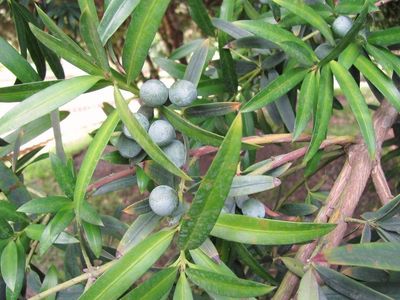About Podocarpus Plum Pines
Unlike most conifers, plum pine trees don’t have cones. Instead, they have single seeds attached to the branch by a fleshy, bluish black branch. The seeds are edible and are often eaten raw or made into jams and jellies (if the birds don’t get them first). Plum pine trees, also known as Illawarra plum, grow slowly the first couple of years, eventually reaching heights of 25 to 40 feet (8-12 m.) in eight to ten years. They usually grow much taller in their natural environment, often topping out at 118 feet (36 m.).
How to Grow Plum Pine Plants
Plum pine is easy to grow by cuttings or seed, but the best way to speed the process is to start with a seedling from a nursery or greenhouse. Plum pine is adaptable to a number of growing conditions as long as the soil is well drained. The tree can handle moist soil but is likely to develop root rot in soggy conditions. It does well in sandy soil and coastal conditions, including salty sea spray. Plum pine trees, which grow in full sunlight or partial shade, are also relatively drought tolerant. Mature trees can usually withstand frost, but young trees are more susceptible to damage. Plant two or three trees to increase your chance of success, as trees are either male or female.
Tips on Plum Pine Care
Water a newly planted plum pine regularly, keeping the soil evenly moist but never soggy, until new growth appears, which indicates the tree has rooted successfully. Plum pine trees benefit from a light application of an all-purpose plant food in late winter or early spring. If growth appears sluggish, fertilize again in summer and early autumn. Avoid fertilizing in late autumn if there is danger of frost in your area, as new growth is more susceptible to damage. Trimming side branches will result in bushier growth. Otherwise, it’s best not to prune plum pine trees, but you can prune lightly with clippers or shears any time of year if the tree is looking shaggy.
